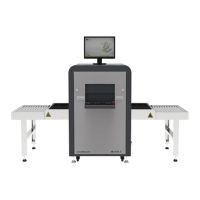
Do you have a question about the ZKTeco ZKX Series and is the answer not in the manual?
| Brand | ZKTeco |
|---|---|
| Model | ZKX Series |
| Category | IP Access Controllers |
| Language | English |
Adherence to ISO1600 safety standards for imaging films.
Essential safety checks to perform before turning on the system.
Fundamental safety guidelines for operating the X-Ray Inspection System.
Measures to ensure operator and user safety from radiation exposure.
Explanation of how the X-Ray Inspection System operates, including its modules.
Key technical data and parameters of the X-Ray Inspection System models.
Highlights the key features that ensure secured, convenient, and faster service.
Lists the sectors and locations where the X-Ray Inspection System is used.
Step-by-step instructions for powering on the X-Ray Inspection System.
Procedure for placing items and the inspection process.
Steps for safely shutting down the X-Ray Inspection System.
Explanation of system indicators and the emergency stop button function.
Details and functions of the special keyboard used for system operation.
Information on using a PC keyboard and mouse for system operation and shortcuts.
Overview of the primary graphical user interface for scanning.
Introduction to the system software panel and its components.
Description of the information displayed on the software interface, including status.
Explains the control buttons for image manipulation and conveyor movement.
Overview of various functions for enhancing and processing scanned images.
Configuration settings for system parameters and user management.
Settings and preview options for managing scanned images.
Functions for adding, managing, and configuring user accounts and permissions.
Tools for managing system logs, including startup, session, and radiation logs.
Features and procedures for Threat Image Projection training and assessment.
Methods and procedures for training operators on image reading and article identification.
Configuration options for intelligent identification, keyboard, and counter settings.
Displays statistics on system running time and configurations.
Procedures for logging out the current user and shutting down the system.
Guidelines for optimal installation environment to ensure system performance.
Procedures for routine cleaning of the equipment's exterior and interior.
Checks and inspections for ensuring proper functioning of key components.
Recommendations for storing the equipment when not in use or during dismantling.
Guidance on identifying and resolving common equipment failures and issues.
